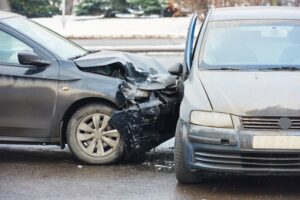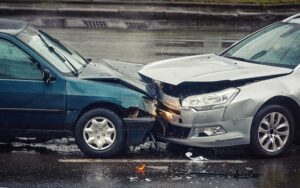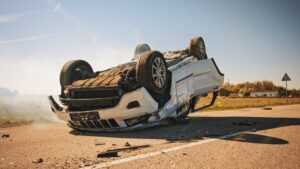Many different types of car accidents happen daily. Understanding common collisions can help you stay alert and drive defensively to avoid them. If you are involved in a crash, knowing what happened is necessary to protect your rights when filing an insurance claim or legal case.
If you or a loved one has suffered an injury in a car wreck, an experienced Phoenix car accident attorney can pursue compensation for your losses.
Rear-End Collisions
One of the most frequently occurring types of car accidents is the rear-end collision. This is when the front of one vehicle slams into the back of the automobile in front of it.
There are several reasons why a rear-end accident might happen:
- Following too closely behind another vehicle and not leaving enough space to brake
- Distracted driving, such as texting, eating, or adjusting the radio and not noticing that traffic has stopped
- Speeding and being unable to slow down in time
- Driving under the influence of alcohol or drugs and having slow reflexes
- Fatigued driving and not reacting quickly enough
- Bad weather like rain, ice, or snow causing slippery roads and increased stopping distances
- Vehicle malfunctions such as failed brakes
- Road hazards like potholes or debris that require sudden braking
The vehicle that rear-ends the other is usually considered to be at fault, as drivers are expected to follow at a safe distance so they can stop in time. However, there can be some situations where the lead vehicle may be partially liable, such as if their tail lights were out or they slammed on their brakes for no reason.
Always have a car accident lawyer assess liability for your collision.
Side-Impact Crashes

Another very common type of collision is the side-impact or T-bone crash. This is when the front end of one vehicle strikes the side of another, forming a "T" shape at the point of impact. Side-impact wrecks are frequently the result of one vehicle failing to yield the right of way to another at an intersection.
Crashes at intersections can happen due to:
- Drivers trying to speed through a light that's turning red
- Distracted drivers not seeing the light has changed
- Misjudging the speed of oncoming traffic when making a turn
- Not seeing a stop or yield sign
- Driving under the influence and making poor judgments
Side-impact collisions can also happen when a vehicle veers out of its lane and sideswipes another car traveling in the same direction. This may occur when a driver is distracted, drowsy, or impaired and drifts across the center line or off the side of the road. Improper lane changes and merging, often due to blind spots, can also cause sideswipe accidents.
Potential injuries from being T-boned include:
- Head trauma
- Concussion
- Skull fracture
- Traumatic brain injury
- Neck and spinal cord injuries
- Paralysis
- Crushed or shattered limbs
- Internal organ damage
- Extensive bruising and lacerations
Head-On Collisions

Head-on crashes are some of the most deadly. This occurs when two cars traveling in opposite directions smash directly into each other, front end to front end. While head-on collisions are less common than rear-end or side-impact accidents, they have a much higher fatality rate due to the combined forces involved.
Head-on wrecks often happen when:
- A driver crosses the center line into oncoming traffic
- A driver goes the wrong way down a one-way street or highway ramp
- A driver tries to overtake another vehicle without enough clearance
In many head-on crash scenarios, the at-fault driver was under the influence of alcohol and/or drugs. Impaired drivers may fall asleep at the wheel and veer across the center line or median. Or they may become disoriented and go the wrong way on a road.
Driver fatigue is another major risk factor, as a very drowsy driver can easily nod off and cross into opposing traffic. Distracted drivers looking at their phones may also drift across the center line.
Rollover Accidents

A rollover accident is when a vehicle flips onto its side or roof, often rolling over multiple times before stopping. While any type of automobile can technically roll over, taller, more narrow vehicles like SUVs, pickup trucks, and vans are more susceptible and have a higher center of gravity.
Rollover crashes commonly occur due to:
- Taking a curve or exit ramp too fast and losing control
- Over-correcting after veering off the pavement
- Swerving sharply to avoid an object in the road
- Hitting a curb, pothole, or soft roadside shoulder
- Getting hit by the swinging trailer of a large truck
- Tire blowouts causing loss of vehicle control
- Top-heavy vehicles in high cross-winds
- Driving under the influence, distracted, or drowsy
Single-Vehicle Accidents
While we often think of accidents as involving two or more vehicles, single-vehicle crashes are actually quite common. A single-vehicle accident is when an automobile crashes or hits a stationary object without another car involved.
Many scenarios can lead to a single-vehicle accident:
- Swerving to miss an animal in the road and hitting a tree, pole, or guardrail
- Losing control on a wet or icy road and sliding into a ditch
- Driving too fast around a curve and rolling over
- Hitting a large pothole and crashing
- Striking a pedestrian or bicyclist on the shoulder or sidewalk
- Failing to negotiate a sharp turn and going down an embankment
- Hydroplaning on standing water and running off the road
Never assume you are to blame for your single-vehicle crash until you speak with a car accident attorney.
Multi-Vehicle Pileups
Some of the most destructive, large-scale traffic accidents are multi-vehicle pileups. These massive chain-reaction crashes can sometimes involve dozens or even hundreds of automobiles. Multi-vehicle pileups often happen when there is low visibility due to fog, heavy rain, sandstorms, or blizzards. Vehicles driving too fast for conditions can't stop in time and crash into others, sparking a chain reaction.
Contact a Car Accident Lawyer for Help
No matter what type of car accident happened, the physical, emotional, and financial impact can be immense. An experienced car accident attorney can be your advocate during this challenging time and fight for the compensation you need to rebuild your life. Reach out to a personal injury lawyer today for a free consultation.